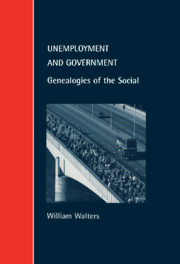Book contents
- Frontmatter
- Contents
- Acknowledgements
- Introduction
- 1 The Discovery of Unemployment
- 2 Inventing Unemployment: The Birth of the Labour Exchange
- 3 Governing Unemployment as a ‘Risk’
- 4 Governing Through the Long-Term Unemployed: Unemployment Between the Wars
- 5 Unemployment and its Spaces
- 6 Governing Divided Societies: The New Deal
- Conclusion
- Notes
- Index
4 - Governing Through the Long-Term Unemployed: Unemployment Between the Wars
Published online by Cambridge University Press: 07 September 2010
- Frontmatter
- Contents
- Acknowledgements
- Introduction
- 1 The Discovery of Unemployment
- 2 Inventing Unemployment: The Birth of the Labour Exchange
- 3 Governing Unemployment as a ‘Risk’
- 4 Governing Through the Long-Term Unemployed: Unemployment Between the Wars
- 5 Unemployment and its Spaces
- 6 Governing Divided Societies: The New Deal
- Conclusion
- Notes
- Index
Summary
During the inter-war years the centre of gravity of the employment problem, as far as official perceptions are concerned, shifted from casual employment to ‘long-term unemployment’. Most of the literature on this period takes as self-evident the existence of a group identifiable as the ‘long-term unemployed’. While there can be no disputing the fact that millions of people had direct and indirect experience of the devastating effects of prolonged joblessness and poverty during this time, this chapter cautions against accepting the validity of this relatively new categorization of the unemployed at face value. Instead, it argues that the social consequences of mass unemployment were in fact managed, partly at least, in terms of a division of the unemployed into a ‘normal’ and a ‘chronic’ population. While this division of the unemployed population was not without its precedents, it came to serve new political functions during the inter-war years.
The first section shows how the ‘long-term unemployed’ were, in a sense, invented as a way of perpetuating the fiction that there is such a thing as ‘normal unemployment’ (whose construction I discussed in Chapter 3), and that it can be governed by social insurance. The chapter then goes on to examine some of the perceptual grids which were deployed to give meaning to the long-term unemployed: inter-war social psychologies, sociologies, ethnographies, and social surveys of the unemployed are all discussed as intellectual technologies which were used to make long-term unemployment interpretable.
- Type
- Chapter
- Information
- Unemployment and GovernmentGenealogies of the Social, pp. 75 - 97Publisher: Cambridge University PressPrint publication year: 2000

